Greek science
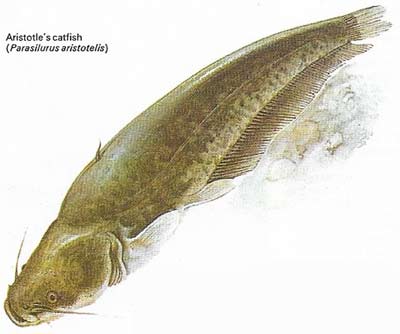
Figure 1. Aristotle's biological observations include notes on bees and fish. He discovered that the male catfish takes upon himself to guard the eggs of the female until the young hatch. Since other catfish species behave differently, this was questioned until the 1850s, when Aristotle was proved correct by Louis Agassiz, who found that the North American catfish (Amieurus) does the same.
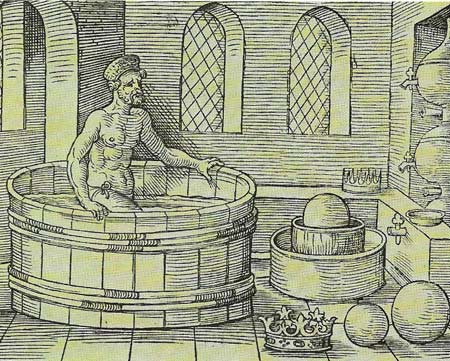
Figure 2. Archimedes in his bath (from a 16th-century engraving) is a reminder of his discovery that a body displaces fluid equivalent to its volume. This means that, regardless of shape, objects of equal density and weight displace the same quantity of fluid. Archimedes used the new principle to determine if a crown made for the king of Syracuse was of unalloyed gold. The crown displaced more water than the same weight of pure gold, proving that it contained other metal.
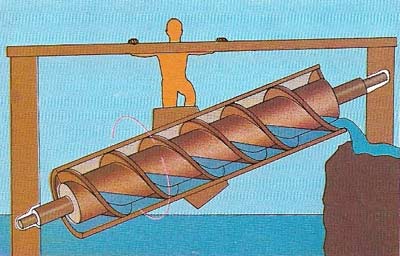
Figure 3. The Archimedean screw for raising water may have originated before Archimedes but was attributed to his mechanical skill. Driven by a handle or foot pedals, the spiraling screw rotates in a cylinder, drawing the water upwards.
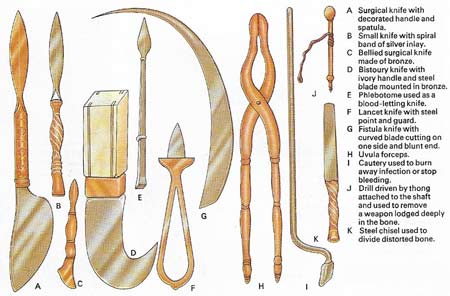
Figure 4. Greek medicine had a long and notable history; psychological medicine was practiced in healing temples, as were herbal treatment and surgery. A miscellaneous collection of Greek surgical instruments shows, among other tools, forceps, and scalpels of various designs.
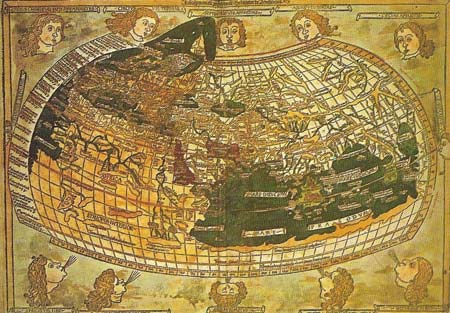
Figure 5. This map of the world, published in 1486, was based on one drawn by Ptolemy in Alexandria some 1,200 years earlier. That map drew on evidence from travellers, especially the Greek explorer Pythias of the 4th century BC.
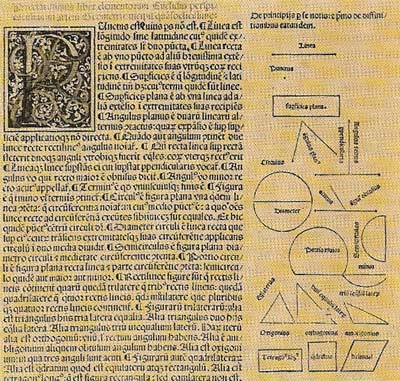
Figure 6. The great basic text on Greek geometry was Euclid's Elements. This page is from the first printed edition, 1482.
The earliest stirrings of Greek science are found in the 8th century BC in the Homeric poems with descriptions of the stars and an unusual concept of the universe as a sphere (Figure 1). Other civilizations had been content with hemispherical skies but it was the Greek love of symmetrical shapes that led them to the concept of a spherical universe.
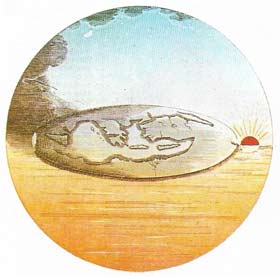 |
| A Victorian illustration of the Homeric universe shows a disk-shaped earth with Greece as its center, floating on water and surrounded by the sphere of the universe. The Sun is rising in the east and the moon is shown high in the sky. Most Greek philosophers thought that the Sun, Moon and planets all orbited the earth: their innovatory idea was that the heavens were an all-embracing sphere, a more perfect shape than a dome or hemisphere. There was no evidence to support this view of the universe; it was adopted purely for aesthetic reasons. But the belief that Earth was at the center of the universe remained until Copernicus' work in the 16th century. |
Greek studies of the universe
The first Greek scientific men whose names are known – Thales, Anaximander, and Anaximenes – came from the eastern seaboard of the Aegean and lived during the 6th century BC. Thales accepted the spherical universe and believed that water was the basic substance from which everything was formed. Anaximander, who thought some indefinable substance (not water) was the basic material, taught that the earth was cylindrical in shape and, like Anaximenes, he believed the heavenly bodies were holes in a dark sky through which shone a surrounding fiery zone. The most important 6th-century scientist was Pythagoras, best known for his proof of the relationship between the sides of any right-angled triangle. He also investigated musical harmony, which led him to suggest that there was a divine relationship be-tween numbers, music and the universe.
Significant developments in the 4th century BC followed the establishment by Plato (c. 427–347 BC) of an academy in Athens, where he laid great stress on the mathematical nature of the universe. His pupil Aristotle (384–322 BC), the greatest scientific philosopher of antiquity, set up his own academy – the Lyceum – also in Athens. He adopted the theory, first formulated by Empedocles in the 5th century BC, of the Four Elements – earth, air, fire and water – as the fundamental components of all matter. Astronomically, Aristotle discussed whether or not the earth moved in space but, on the basis of the available evidence, he tended to favor a fixed earth in the center of the universe. Aristotle also discussed the nature of change and especially of motion, as well as teaching that there was a fundamental difference between celestial and terrestrial bodies. The former were eternal and changeless, and all change, he believed, must occur below the sphere of the Moon, the nearest body to the earth. He also rejected the idea, proposed in the 5th century BC by Democritus and Leucippus, that the universe is composed of separate and indestructible atoms.
Investigations in the pure sciences
Although it was Aristotle's views about the physical universe that exerted the most profound influence on science for the following 2,000 years, he was at his best in the biological field. He carefully described the compound stomach of ruminants such as the cow and the habits of bees and the diseases they suffered; he studied the placental dogfish that reproduces its young live rather as a mammal does and made a general study of sexual reproduction (Figure 1) He also studied plants, although it was his friend and disciple Theophrastus (c. 372–c. 286 BC), who was the founder of botanical science. Aristotle emphasized the important notion that there is a continuous order of being stretching from inanimate matter up to man.
Following the claim by Eudoxus (c. 408–c. 355 BC) that heavenly bodies moved in circular orbits round Earth, the 3rd-century astronomer Aristarchus (310–230 BC) suggested that the Sun, not Earth, was the center of the universe and discussed the sizes of the Sun and Moon. But his theory of the universe proved unacceptable. A century later, Hipparchus (190–120 BC), the greatest observational astronomer of antiquity, discovered the precession of the equinoxes, compiled a catalogue of stars, calculated solar eclipses and had an advanced theory of the Sun's motion. The 3rd century BC is notable also far the mathematical physics of Archimedes (c. 287–212 BC) (Figure 2) and the establishment of the library and museum of Alexandria. There, for the next 500 years, research of an advanced kind was carried out; mathematics flourished with Euclid (fl. c. 300 BC) (Figure 6) and Apollonius (fl. 250–220 BC), who was noted for his work on astronomy and conic sections. Eratosthenes (c. 276–194 BC) estimated the earth's circumference to within 400 kilometers (250 miles).
In the 2nd century AD the astronomer Ptolemy (c. 90–168) produced his remark-able Almagest, a digest of Greek astronomy, and his Geography, using longitude and latitude as well as his own stereographic map projection (Figure 5). The medical lore of Hippocrates of Cos in the 5th century BC was developed by Herophilus and Erasistratus in Alexandria two centuries later (Figure 4). They dissected the human body, distinguishing veins from arteries, sinews from nerves, and generally laying the foundations of anatomy.
Applied sciences and the study of machines
The compound pulley was known in Aristotle's time and the screw for raising water was invented in Syracuse by Archimedes. Much Greek technology, however, was also developed at Alexandria where, in about 200 BC, Ctesibius designed water clocks and a force-pump, and in the 1st century AD Hero not only developed the study of machines and pneumatic devices (although he failed to find practical uses for his inventions) but also improved surveying techniques. The discovery of a mechanically geared "computer" for astronomical calculations suggests that Alexandrian technology had a wide influence.
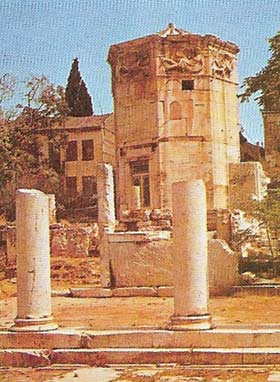 |
| The Tower of Winds in Athens is surrounded at the top by sundials. It once held a large clepsydra (water clock), based on a design by Ctesibius. This had an elaborate siphoning system to maintain a constant water pressure so that the clock was reasonably accurate. |
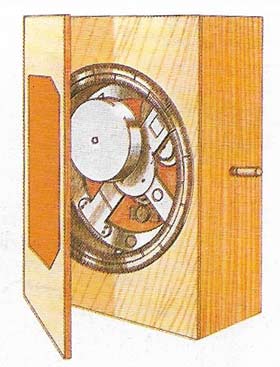 |
| A Greek astronomical "computer" was discovered in 1900 in a wreck dating from about 65 BC off the island of Antikythera and is shown in reconstruction here. It contained an extremely elaborate system of internal gears. |
